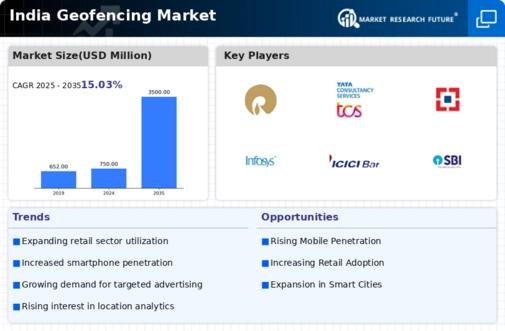Growth of Mobile Applications
The proliferation of mobile applications in India is a significant driver for the geofencing market. With millions of apps available, businesses are increasingly integrating geofencing capabilities to enhance user engagement. Mobile applications that utilize geofencing can provide users with location-specific notifications, offers, and services, thereby improving customer satisfaction. As of 2025, it is estimated that the number of smartphone users in India will exceed 800 million, creating a vast audience for geofencing-enabled applications. This growth in mobile app usage is likely to propel the geofencing market, as developers seek to incorporate location-based features to differentiate their offerings and attract more users.
Increased Focus on Customer Experience
The growing emphasis on customer experience in India is driving the geofencing market. Businesses are increasingly aware that enhancing customer satisfaction is crucial for retaining clients and fostering brand loyalty. Geofencing technologies allow companies to create personalized experiences by sending tailored messages and offers based on customers' locations. This approach not only improves engagement but also encourages repeat visits. Research indicates that businesses that prioritize customer experience can see revenue growth of up to 10% annually. As organizations strive to meet evolving consumer expectations, the adoption of geofencing solutions is likely to increase, further propelling the growth of the geofencing market.
Rising Demand for Targeted Advertising
The geofencing market in India is experiencing a surge in demand for targeted advertising solutions. Businesses are increasingly recognizing the value of location-based marketing strategies to enhance customer engagement. With the proliferation of smartphones, it is estimated that over 500 million mobile users in India are potential targets for geofencing campaigns. This trend is likely to drive the growth of the geofencing market as companies seek to leverage precise location data to deliver personalized advertisements. Furthermore, the ability to track customer behavior in real-time allows businesses to optimize their marketing efforts, potentially increasing conversion rates by up to 30%. As a result, the geofencing market is poised for significant expansion, driven by the need for more effective advertising methods.
Expansion of E-commerce and Retail Sectors
The rapid growth of the e-commerce and retail sectors in India is a crucial driver for the geofencing market. With online shopping becoming increasingly popular, retailers are adopting geofencing technologies to enhance customer experiences. For instance, businesses can send promotional offers to customers' smartphones when they enter a defined geographical area, thereby increasing foot traffic to physical stores. According to recent estimates, the Indian e-commerce market is projected to reach $200 billion by 2026, which could further fuel the adoption of geofencing solutions. This integration of geofencing in retail strategies not only improves customer engagement but also provides valuable insights into consumer behavior, thereby driving the growth of the geofencing market.
Government Initiatives for Smart Infrastructure
Government initiatives aimed at developing smart infrastructure in India are significantly influencing the geofencing market. The Smart Cities Mission, launched by the Indian government, aims to create urban spaces that utilize technology for efficient management and improved quality of life. Geofencing technologies can play a pivotal role in these smart city projects by enabling real-time monitoring of traffic, public safety, and resource management. As cities adopt smart solutions, the demand for geofencing applications is expected to rise. This could lead to an increase in investments in the geofencing market, as local governments and private entities collaborate to implement innovative solutions that enhance urban living.

















Leave a Comment